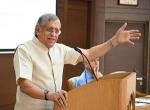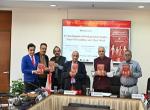On January 2, 2025, the Vivekananda International Foundation (VIF) hosted a discussion on Professor Daya Thussu’s book, Changing Geopolitics of Global Communication. The session began with opening remarks by Dr. Arvind Gupta, Director of VIF, followed by an overview of the book by Professor Thussu. Amb. Venkatesh Varma and Prof. Sujit Dutta contributed as discussants, exploring themes such as the transformation of global communication infrastructure, the weaponization of cyberspace, and the role of digital platforms in development. The dialogue emphasized the primacy of communication in shaping international relations and analysed emerging dynamics, including the influence of China, media's role in information warfare, and the implications for India’s global strategy.
Global Media Landscape and Geopolitical Shifts
As the 21st century progresses, global geopolitics is witnessing a shift from the dominance of the US-led Western order to the rise of emerging powers like China, Russia, and India. This "rise of the rest" challenges the traditional conception of geopolitics, particularly in an increasingly digitized and interconnected world. While Western nations and corporations continue to mediate global narratives, the BRICS countries, notably China and Russia, are reshaping how geopolitics is communicated.
However, India has yet to fully harness its potential in this evolving landscape. Despite its advantages as the world’s largest democracy, a rapidly growing economy, a vibrant English-language media, and an influential diaspora, India’s global media presence remains limited compared to China’s expansive and well-resourced communication strategies.
China’s Ascendancy in Global Communication
China’s rise as a dominant force in global communication is a central theme of the book. Over the past decade, China has leveraged state-owned media outlets like Xinhua News and digital platforms such as WeChat to amplify its global narrative. These efforts align with broader geopolitical ambitions, including the Belt and Road Initiative, which extends China’s influence in the Global South.
In contrast, India—despite its rich cultural heritage and democratic values—has struggled to achieve similar global traction. The discussion highlighted how China’s communication strategies challenge Western narratives and fill gaps where Western media presence is minimal, offering a blueprint for India to consider.
Amplification of Power Imbalances through AI
The integration of AI technologies into media and communication has deepened global power imbalances. Dominant players in technology and media have leveraged AI to consolidate their influence, leaving countries like India dependent on foreign platforms like Facebook, WhatsApp, and TikTok. This dependency risks marginalizing India’s voice in the rapidly evolving global digital ecosystem.
Misunderstood Soft Power
India often overestimates the power of its cultural appeal, historical significance, and democratic ideals. While these elements are important, they cannot replace the influence derived from economic and military strength. As Joseph Nye has argued, soft power is most effective when paired with robust hard power. Unlike China, which effectively balances both, India’s reliance on soft power alone limits its global impact.
Western Media Dominance and Bias
Western media outlets like The Washington Post and The Economist continue to shape global narratives, often portraying India in a narrow and critical light. This bias skew international perceptions and influences domestic audiences, including India’s middle class. The discussion emphasized the need to counter these entrenched biases by diversifying global media representation.
India’s Role in Global Media and Communications
India’s underrepresentation in global media remains a significant challenge. For instance, during the Russia-Ukraine conflict, only 2% of reports came from Indian correspondents, highlighting India’s limited global reach. The absence of Indian voices in critical regions, such as Russia, further underscores this gap.
India’s intellectual and academic frameworks, largely rooted in Western theories, also restrict its ability to influence global discourses. Decolonizing these frameworks and fostering indigenous perspectives are essential steps for India to enhance its intellectual and policy contributions on the international stage.
The country’s fragmented approach to international communication exacerbates the problem. India lacks a cohesive infrastructure for content creation and dissemination, as well as a unified communication strategy. Efforts like PTI International failed due to internal resistance and a lack of vision, leaving India reliant on Western media content.
Another key issue is the over-reliance on bureaucratic leadership within media and intellectual institutions. Appointing experts with specialized knowledge in global communication and media strategy could significantly enhance India’s ability to project its narrative effectively.
Strategic Recommendations
- Invest in Media Infrastructure: India needs to develop independent media platforms and digital tools that can counter Western biases and present alternative narratives on global issues.
- Promote Intellectual Engagement: Greater participation in international think tanks, academic forums, and conferences is essential to strengthen India’s intellectual footprint.
- Leverage the Diaspora: India must strategically engage with its diaspora to amplify its voice abroad, while recognizing the need for alignment with national interests.
- Decentralized Communication Strategy: A unified and strategic "dashboard" to oversee India’s global communication efforts can address inconsistencies and missed opportunities.
- Appoint Experts: Leadership in media and communication institutions should be entrusted to specialists, enabling a more professional and strategic approach to India’s global messaging.
Conclusion
The book Changing Geopolitics of Global Communication offers a timely analysis of the interplay between media, communication, and geopolitics in a rapidly transforming world. The discussion underscored the need for India to rethink its global communication strategy. By aligning soft power with hard power, investing in independent platforms, and fostering stronger leadership in international organizations, India can enhance its influence and ensure its voice is heard in the evolving global order.







Post new comment